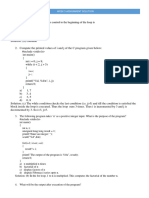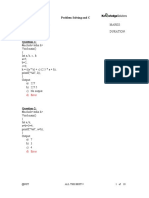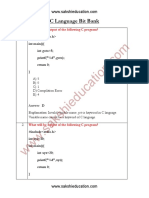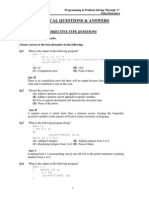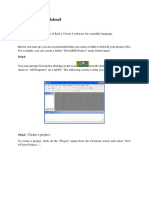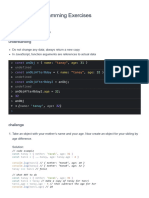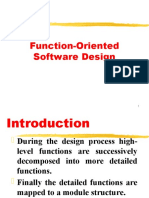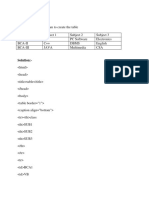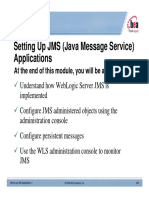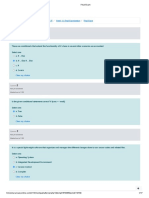Problem Solving through Programming in C
Week 03 Assignment Solution
1. The precedence of arithmetic operators is (from highest to lowest)
a) %, *, /, +, –
b) %, +, /, *, –
c) +, -, %, *, /
d) %, +, -, *, /
Solution: (a) The precedence order follows the first option (a)
2. Which of the following is a logical operator in C?
a) &&
b) ==
c) =
d) +=
Solution: (a) The && operator is a logical AND operator in C.
3. What is the output of the following program?
#include <stdio.h>
int main()
{
float i = -3.0;
int k = i % 2;
printf("%d", k);
return 0;
}
a) -1
b) 1
c) 0
d) Compilation error
Solution: (d) 'int to binary ' operator ‘%' cannot be operated on a floating variable. Thus, i%2 is not a valid
operation in C. The compiler will show an error at this step.
4. Find the output of the following C code. (% indicates modulo operation, which results in the
remainder of a division operation)
#include<stdio.h>
int main()
{
int a=10, b=3, c=2, d=4, result;
result=a+a*-b/c%d+c*d;
printf("%d", result);
return 0;
}
a) -42
b) 24
c) 15
d) -34
�Problem Solving through Programming in C
Week 03 Assignment Solution
Solution: (c) Following the precedence rule, we can conclude that the operation steps are
Result=10+10*- 3/2%4+2*4
Result=10-30/2%4+2*4
Result=10-15%4+2*4
Result=10-3+2*4
Result=10-3+8
Result=7+8
Result=15
5. What is the output of the following C code?
#include <stdio.h>
int main()
{
int h = 8;
int b = 4 * 6 + 3 * 4 < h*5 ?4 : 3;
printf("%d\n", b);
return 0;
}
a) 0
b) 3
c) 4
d) Compilation error
Solution: (c) ‘?:’ is Conditional Expression. If Condition is true ? then value X : otherwise value Y. After
simplifying the expression, we get 36<40?4:3. The condition in LHS of ? is true. Thus 4 will be stored in b.
6. What will be the output of the following C code snippet?
#include <stdio.h>
int main() {
int x = 1, y = 0;
if (x && y) {
printf("Both are true\n");
} else {
printf("At least one is false\n");
}
return 0;
}
a) Both are true
b) At least one is false
c) Compilation error
d) None of the above
Solution: (b) Since y is 0, the condition x && y evaluates to false, so "At least one is false" will be printed.
�Problem Solving through Programming in C
Week 03 Assignment Solution
7. What will be the output of the following C code?
#include <stdio.h>
int main() {
int x = 10;
if (x = 5) {
printf("x is 5\n");
} else {
printf("x is not 5\n");
}
return 0;
}
a) x is 5
b) x is not 5
c) Compilation error
d) None of the above
Solution: (a) The condition if (x = 5) is an assignment, not a comparison. It assigns 5 to x, which evaluates
to true, so "x is 5" will be printed.
8. What will be the output of the following C code?
#include <stdio.h>
int main() {
int a = 10, b = 5;
if (a > b)
if (b > 0)
printf("b is positive\n");
else
printf("b is non-positive\n");
printf("a is greater than b\n");
return 0;
}
a) b is positive
b) b is non-positive
c) a is greater than b
d) b is positive a is greater than b
Solution: (d) Both "b is positive" and "a is greater than b" will be printed because the second printf is not
part of the inner if-else block.
9. Which of the following methods are accepted for assignment?
a) 8=x=y=z
b) x=8=y=z
c) x=y=z=8
d) None
Solution: (c)
�Problem Solving through Programming in C
Week 03 Assignment Solution
10. What will be the output?
#include<stdio.h>
int main()
{
int x;
x= 9<5+3 && 7;
printf("%d", x);
return 0;
}
a) 0
b) 1
c) 7
d) Compilation error
Solution: (a) 0
This expression is equivalent to:
((9< (5 + 3)) && 7)
i.e., (5 + 3) executes first resulting into 8
then, the first part of the expression (9< 8) executes, resulting in 0 (FALSE)
Then, (0 && 7) execute resulting into 0 (FALSE)
























